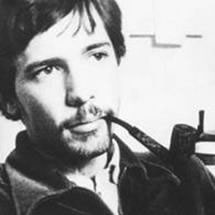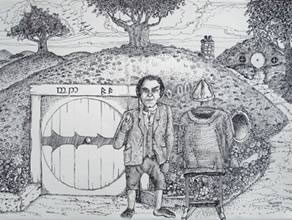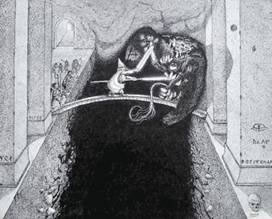Interview with James Dunning - Tolkien artist (24.02.07)
< Portrait of the Artist as a Young Hobbit.
Exploring Middle-earth through the Art of James Dunning
Q: Can you tell us a little about yourself?
Well, I am a citizen of Planet Earth with multicultural interests who once resided in Europe. My Shire and base of operations is ~50 km outside Atlanta. Profession? I have been a newspaper urchin, student, linguist-translator, soldier, pharma researcher, archivist, author, editor of technical reports, and a musician in Irish and international music. But I have been an “artist” throughout, though I know how it works: if my legacy survives future generations will decide whether I indeed was an artist.
Q: When did you discover that you could draw?
Having doodled compulsively since I can remember, I cannot say. I clearly recall drawing down in the floorboard between front and back car seats on a long journey to see my grandparents. I was either three or four then. I sketched a rabbit peeing. My mother stifled a chuckle at my crude abstractionist technique, and made it clear she did not approve of my subject. Today such themes are Fine Art in certain hotels in Europe! My little brother had a most expansive vision I admired: at two he executed crayon murals on our closet wall. These did not survive for review by posterity.
Q: What first interested you in Professor tolkien's works?
At sixteen a classmate I respected was starry-eyed over H/lotr. There’s no endorsement like genuine enthusiasm, so I lost no time procuring the entire Cycle (then less than US$ 4.00). By then my linguistic aspirations were in full swing, with Latin, Greek, German and Russian. Reading The Rings was thus a linguistic banquet, a rare panorama of our English language and its various Germanic roots. I was a prime candidate to be swept away, having teethed upon Greek mythology, Andrew Lang’s Fairy Books, King Arthur and his Knights, The Song of Roland, The White Company, Norse Mythology retold by Padraic Colum, etc. Tolkien orchestrates his history in such depth and exquisite detail. Tolkien’s spiritual dimension and his love of nature enchanted me.
Q: I'd like to talk about your art in A Tolkienian Mathomium. What was your inspiration for “Bilbo and the Mathom House”?
I had other visions, but not the time to execute them. The lintel features “MD” for Michel Delving in both Tolkien scripts. Some of the original’s detail turned out a bit hazy in the photo featured online. Once on the train in Germany I sat opposite a man whose face struck me like a thunderbolt: AHA! BILBO BAGGINS! Seeing the expression on my face I’m sure the poor fellow thought I was nuts. I had no camera to record his likeness, but tried to draw him from dim memory, and didn’t entirely succeed.
Q: What was your inspiration for “The Bridge of Khazad Dum”?
<reproduced on the cover of the October 2006 issue of Beyond Bree>
One column has been defiled with Orkish inscriptions: AZOG and a nine-rayed Eye of Sauron. In the foreground is a skull branded with the name of AZOG. Could this be the fabled skull of Thrór, preserved as a grim trophy by the Orcs? Thrór’s skull was never recovered by Nár, who fled weeping from the Orcs down the Silverlode bearing his pitiful sack of coins.
Q: What media do you work in?
Actually I do not limit myself to any medium, although the stark simplicity of black and white pen and ink drawings always holds especial appeal, probably because I treasure the fine black and white etchings of eminent artists M.C. Escher and Gustave Doré (not that I presume to be in their league). This medium also reproduces well. But I have drawn and painted in acrylic, oil, Rembrandt pastels, watercolors, pencils, charcoal, felt-tip, even ballpoint.
Q: Why did you do these drawings in black and White?
The Bridge of Khazad-Dûm lends itself well to black and white rendition, with the gloom of Moria and the stark contrast of light versus darkness. Bilbo and the Mathom House I executed likewise in black and white because it reproduces well using the technology available for A Tolkienian Mathomium. I also tried to use a style consistent with Tolkien’s illustrative style in The Hobbit.
Q: Do you ever work in color?
All the time! I have mentioned paintings, pastels and watercolors. I’ve sculpted a castle in styrofoam with working wooden drawbridge and portcullis.
Q: Did you ever think about (or are you already) selling full-sized reproductions of this and the other drawings?
A great question! Indeed my enterprise Dolmen Tree Art has a website nearing completion, dolmentreeart.com. The website features Tolkien art available for purchase, Celtic motifs and standing stones, which I always loved; my first oil painting (at 18) was a ring of standing stones as timeless sentinels on a ridge above the sea. There are also drawings conceived by thinking in other categories, on fantastic themes, some with temporal or spatial paradox. Some scenes come to me in lucid dreams. Most things I have done of course are not online. The online portfolio will grow. It’s all B&W now, but I foresee expansion into COLOR!
Q: When looking up the word Mathomium in the dictionary it does not exist (Tolkien fans do of course know the word Mathom); how did you come up with this title?
Well, I recommended to Mark that he incorporate his fine articles into his own book, but its title is Mark’s own. However Mark and I are much alike: we both delight in playing linguistic games across several languages. Mark couches an earthy Anglo-Saxonism in elegant, erudite Latinate to mean “a collection of mathoms.” Mathom absorbed into the ascendant culture of Virgil and Cicero creates a high linguistic jest readily apparent to the genuine Tolkien enthusiast to whom Mark’s book appeals. Remember the word quiz. As legend has it, James Joyce and his motley intellectual irregulars scrawled this nonsense word all over public buildings, walks and Liffey bridgeheads in Dublin. Zany experiments in sociolinguistic psychology turn neologisms into full-time words when a word sticks.
Q: What is unique about your art? What makes it different from that of other artists who find their inspiration in Tolkien and The Lord of the Rings?
There are many fine Tolkien artists I admire, and my own “public” Tolkien art by comparison is in its relative infancy. From what you have seen, you can divine the linguistic element I incorporate whenever possible. My art is also idiosyncratic, deriving from thinking in other categories. Many pieces have at least one little secret (or more) awaiting an observant eye and a prepared mind.
Q: Where do you draw?
Like our beloved Professor, I like to work in a converted garage, on a broad desk which I declutter to serve as my studio. But the U.S. is not Oxford: our socio-economic organization will not work without wheels, so unlike our Professor, I must depend on the automobile. Therefore I don’t have quite as much garage space as he did.
Q: We also saw some nice articles from your hand about Tolkien translations.
Are you planning more articles, or even a book, in the future?
I much appreciate your kind feedback. In a word: yes. In Beyond Bree Nancy Martsch mediates many a stimulating forum among scholars and observant lay readers. There I discovered how satisfying Tolkien commentary can be, and went further. My reflections on Tolkien also incorporate gleanings from a lifetime of reading, including the mathomium (if you will) of human language and linguistics. Tolkien for me is a gateway into many worlds, so a fresh new article comes ever to mind.
Q: When you're not working, what are your favorite ways to relax and have fun?
In fact I am juggling several careers and I get hit by the wanton blows and bashes of life like everyone else. And I’m swamped with so many new visions, it’s hard to relax, like a computer thrashing with so many tasks, it cannot decide which to start first. But I love to read (4000+ books), and to peruse various media, where a random image can evoke a compelling new idea. I’m also playing Irish / Celtic music with a local band. I’ve built musical instruments from gourds.
Also when I find a way I would publish my own ‘suspense novel’ about synchronicity and “sixth senses” in real life. The novel does not stand on Tolkien’s shoulders, yet I believe the Professor would nod with recognition: remember the Eldar can converse mind-to-mind without speaking. Devotees of Smith of Wootton Major might recognize an elusive Elven-star like that on Smith’s brow, which not everyone can see.
Q: One final question. What do you think about the Hobbit movie?
What Tolkien enthusiast wouldn’t look forward to seeing it? Although if it is another New Line film, I’d counted on Peter Jackson directing it for continuity’s sake. The Hobbit should be a feast of color and a panorama of natural grandeur with a generous splash of special effects. Yet I still cling to my poignant private vision of Middle-earth, as do all genuine LOTRians, who hope like me that cinema will do justice to the original. The Hobbit is not LOTR. When first I read it I felt ten again and found it delightful! I hope screen writers will not “over-epicize” The Hobbit to make it conform to perceived expectations of LOTR audiences, and thereby petrify its childlike witticisms and atmosphere.


